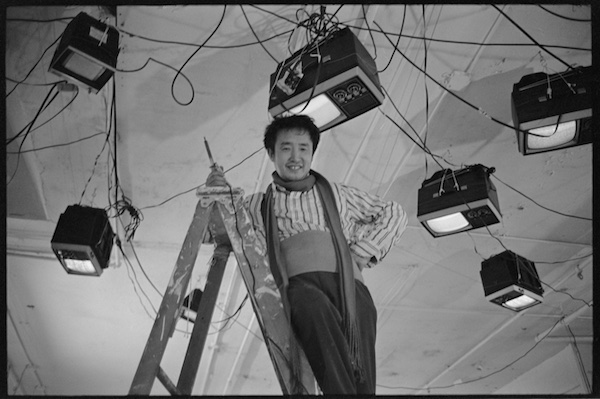Television Review: “Nam June Paik: Moon Is the Oldest TV” — An Artist Who Humanized Technology
By John R. Killacky
An avant-garde iconoclast, Nam June Paik once said “It’s an artist’s job to think about the future.”
Nam June Paik: Moon Is the Oldest TV on PBS’s American Masters, airing on May 16.

Multidisciplinary artist Nam June Paik in 1982. Elliott Erwitt / Magnum Photos
Amanda Kim’s documentary on multidisciplinary artist Nam June Paik (1932-2006) brings long overdue mainstream recognition to a prescient creative rebel. A plethora of his performance and video works, along with actor Steven Yeun reading Paik’s writings, illuminate the man’s sui generis explorations.
Paik once said, “It’s an artist’s job to think about the future.” This compelling film underscores why Paik should be considered the progenitor of video art, his work prophesying an “electronic superhighway … where everybody will have his own TV channel” a decade before the internet even existed.
During the Korean War, Paik’s family fled Seoul and relocated to Japan, where he attended the University of Tokyo. In 1956, the 24-year-old went to Munich to study composition with composer Arnold Schoenberg. His artistic trajectory was radically upended when he attended a 1958 concert by John Cage and David Tudor. Most of the German audience booed and walked out. Paik was transfixed and became a Cage acolyte as well as life-long friend. Poignant footage of their interactions over the ensuing decades highlights their mutual admiration.
Paik also found a home in the Fluxus art movement, which was made up of anti-elitist creatives who deconstructed prosaic activities via performative events that pushed the boundaries of prevailing norms in painting, sculpture, poetry, music, and theater. Toppling pianos, smashing violins, dousing himself with water, and dipping his head into a bowl of ink became part of Paik’s repertory of shenanigans, gloriously documented in photos and performance videos.
For his first gallery show, presented in 1963 at Wuppertal, Germany, Paik dismantled old televisions and encouraged audience members to manipulate the pieces as part of the exhibition. Critics derided the setup as a “room of broken TV’s” — scholars now consider it the birth of electronic art.

Nam June Paik — Galleries did not know what to do with him until his 1974 sculpture featured a seated Buddha statue viewing its own image on a monitor via a closed-circuit video loop. Photo: Peter Moore/Northwestern University / Courtesy Paula Cooper Gallery
Moving to New York in 1964, the artist continued to source, appropriate, and mutate media images from popular culture; his goal was to reengineer/reimagine media into sculptural and robotic installations. He also began a decades-long collaborative partnership with cellist Charlotte Moorman, crafting video components for her performances. Infamously, both were arrested after she performed topless during a happening; charges were later dropped.
Galleries did not know what to do with Paik until 1974, with the arrival of a sculpture that featured a seated Buddha statue viewing its own image on a monitor via a closed-circuit video loop. This simple — yet profound — image resonated to the point of becoming a popular icon. Soon Paik was included in group exhibitions that showcased emergent technologies. In 1982, New York’s Whitney Museum mounted its first ever video art retrospective devoted to his work.

Nam June Paik, The More, the Better, 1988. National Museum of Modern and Contemporary Art, South Korea, 2022. Photo: Woo Jongduk
Paik continually pushed boundaries. With a grant from the Rockefeller Foundation, he went to Boston’s WGBH to learn how to edit and then collage video imagery. Given how labor intensive and costly the operation was, he worked to build a synthesizer that would democratize the process so “you can play the television yourself, like a piano.”
Further experiments with New York’s WNET culminated in 1984’s Good Morning, Mr. Orwell, a live international simulcast seen by 25 million people on New Year’s Day. It featured many of Paik’s art world friends, including George Plimpton, Joseph Beuys, John Cage, Merce Cunningham, Charlotte Moorman, Allen Ginsberg, and Laurie Anderson. As you view archival footage of the program, you can’t help but be impressed — it is amazing that he somehow pulled this ambitious broadcast off.
That same year, after a 34-year hiatus, Paik was welcomed back to Korea as a national hero and was given the resources he needed to create large-scale installations. The artist also served as an aesthetic conduit that connected Korean artists to their international contemporaries. For example, he helped bring the Whitney Biennial to Seoul and was instrumental in founding the Gwangju Biennale. Paik also established the Korea Pavilion at the Venice Biennale.
Debilitated by a stroke in 1996, Paik continued to create intermedia installations until his death in 2006. His Jacob’s Ladder filled the entire rotunda of New York’s Guggenheim Museum: the piece was built out of 100 TV monitors and a seven-story cascading waterfall of lasers.
Nam June Paik’s aesthetics remain strikingly contemporary: for him, artistic agency was about defying limitations at the service of humanizing technology. Perhaps we have finally caught up with the future that he imagined. More than ever, we need Nam June Paik.
John R. Killacky is the author of because art: commentary, critique, & conversation (Onion River Press).
Tagged: Amanda Kim, American Masters, Nam June Paik, Nam June Paik: Moon is the Oldest TV, the Better

John: thank you for sending your essay. I wanted you to know that in 1991 I met Paik at his studio in Soho. It was a wild environment almost a junk yard of broken down TV sets, wires, tubes; a complete mess. He was elfin and endearing. He was a sculptural and visual genius. Warmest regards, Joe
Thank you!